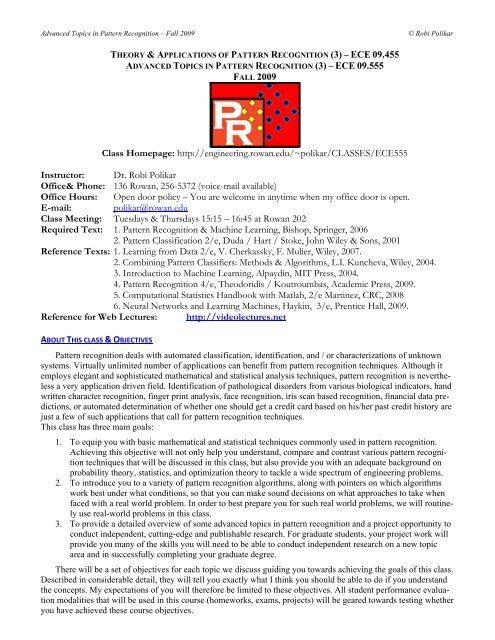Syllabus - ECE 504.04 Pattern Recognition - Rowan
Syllabus - ECE 504.04 Pattern Recognition - Rowan
Syllabus - ECE 504.04 Pattern Recognition - Rowan
You also want an ePaper? Increase the reach of your titles
YUMPU automatically turns print PDFs into web optimized ePapers that Google loves.
Advanced Topics in <strong>Pattern</strong> <strong>Recognition</strong> – Fall 2009<br />
© Robi Polikar<br />
THEORY & APPLICATIONS OF PATTERN RECOGNITION (3) – <strong>ECE</strong> 09.455<br />
ADVANCED TOPICS IN PATTERN RECOGNITION (3) – <strong>ECE</strong> 09.555<br />
FALL 2009<br />
Class Homepage: http://engineering.rowan.edu/~polikar/CLASSES/<strong>ECE</strong>555<br />
Instructor: Dr. Robi Polikar<br />
Office& Phone: 136 <strong>Rowan</strong>, 256-5372 (voice-mail available)<br />
Office Hours: Open door policy – You are welcome in anytime when my office door is open.<br />
E-mail: polikar@rowan.edu<br />
Class Meeting: Tuesdays & Thursdays 15:15 – 16:45 at <strong>Rowan</strong> 202<br />
Required Text: 1. <strong>Pattern</strong> <strong>Recognition</strong> & Machine Learning, Bishop, Springer, 2006<br />
2. <strong>Pattern</strong> Classification 2/e, Duda / Hart / Stoke, John Wiley & Sons, 2001<br />
Reference Texts: 1. Learning from Data 2/e, V. Cherkassky, F. Mulier, Wiley, 2007.<br />
2. Combining <strong>Pattern</strong> Classifiers: Methods & Algorithms, L.I. Kuncheva, Wiley, 2004.<br />
3. Introduction to Machine Learning, Alpaydin, MIT Press, 2004.<br />
4. <strong>Pattern</strong> <strong>Recognition</strong> 4/e, Theodoridis / Koutroumbas, Academic Press, 2009.<br />
5. Computational Statistics Handbook with Matlab, 2/e Martinez, CRC, 2008<br />
6. Neural Networks and Learning Machines, Haykin, 3/e, Prentice Hall, 2009.<br />
Reference for Web Lectures: http://videolectures.net<br />
ABOUT THIS CLASS & OBJECTIVES<br />
<strong>Pattern</strong> recognition deals with automated classification, identification, and / or characterizations of unknown<br />
systems. Virtually unlimited number of applications can benefit from pattern recognition techniques. Although it<br />
employs elegant and sophisticated mathematical and statistical analysis techniques, pattern recognition is nevertheless<br />
a very application driven field. Identification of pathological disorders from various biological indicators, hand<br />
written character recognition, finger print analysis, face recognition, iris scan based recognition, financial data predictions,<br />
or automated determination of whether one should get a credit card based on his/her past credit history are<br />
just a few of such applications that call for pattern recognition techniques.<br />
This class has three main goals:<br />
1. To equip you with basic mathematical and statistical techniques commonly used in pattern recognition.<br />
Achieving this objective will not only help you understand, compare and contrast various pattern recognition<br />
techniques that will be discussed in this class, but also provide you with an adequate background on<br />
probability theory, statistics, and optimization theory to tackle a wide spectrum of engineering problems.<br />
2. To introduce you to a variety of pattern recognition algorithms, along with pointers on which algorithms<br />
work best under what conditions, so that you can make sound decisions on what approaches to take when<br />
faced with a real world problem. In order to best prepare you for such real world problems, we will routinely<br />
use real-world problems in this class.<br />
3. To provide a detailed overview of some advanced topics in pattern recognition and a project opportunity to<br />
conduct independent, cutting-edge and publishable research. For graduate students, your project work will<br />
provide you many of the skills you will need to be able to conduct independent research on a new topic<br />
area and in successfully completing your graduate degree.<br />
There will be a set of objectives for each topic we discuss guiding you towards achieving the goals of this class.<br />
Described in considerable detail, they will tell you exactly what I think you should be able to do if you understand<br />
the concepts. My expectations of you will therefore be limited to these objectives. All student performance evaluation<br />
modalities that will be used in this course (homeworks, exams, projects) will be geared towards testing whether<br />
you have achieved these course objectives.
















